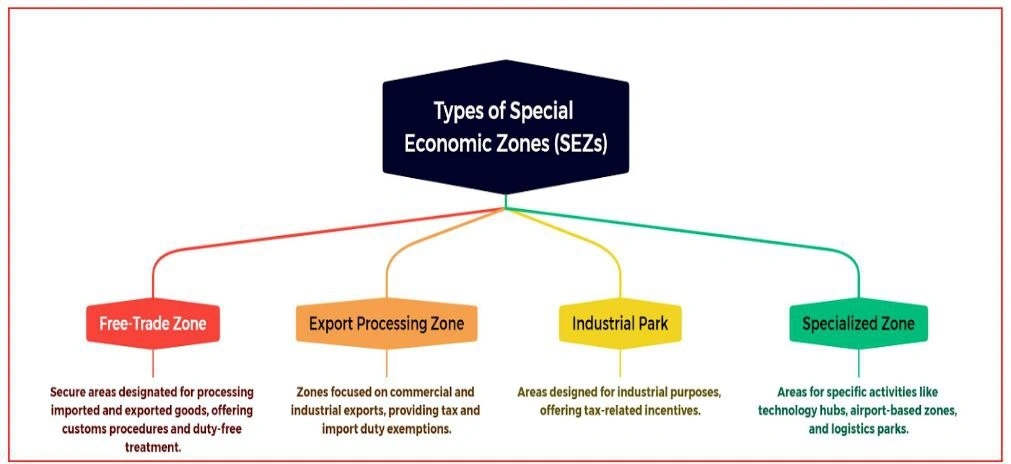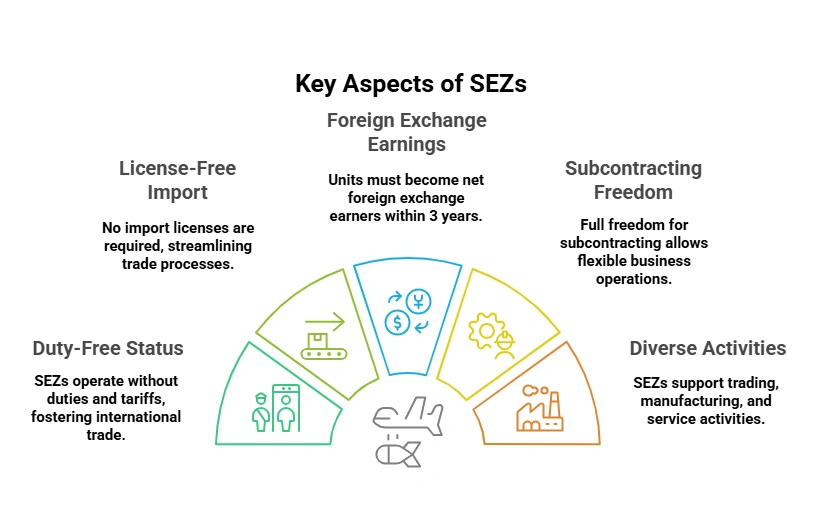Paper: GS – III, Subject: Indian Economy, Topic: Industry and Industrial policies, Issue: Special Economic Zones (SEZs).
Context:
The Indian government aims to boost the production of semiconductors and electronics, reducing reliance on imports, especially after recognizing vulnerabilities in global supply chains during the COVID-19 pandemic.
Key Takeaways:
- Smaller Land Requirements: The minimum land area for semiconductor-only SEZs has been reduced from 50 hectares to 10 hectares, making it more feasible for companies to invest without making large commitments.
- Address Land Issues: The relaxation of the encumbrance-free requirement for SEZ land acknowledges the complexities in India’s land record systems, making it easier for businesses to establish operations without lengthy legal disputes.
- Domestic Market Supply: The rule change allowing SEZs to sell domestically underlines a significant shift from the traditional export-only model, enabling companies to ensure a steady supply to the local market while also mitigating global trade uncertainties.
| An SEZ, or Special Economic Zone, is an area within a country that offers fiscal concessions and different business and commercial laws to encourage investment and create employment. SEZs are established to address infrastructural and bureaucratic challenges and improve the ease of doing business. SEZs in India: The first EPZ (Export Processing Zone) in Asia was set up in 1965 in Kandla, Gujarat.In 2000, the government started establishing SEZs under the Foreign Trade Policy to overcome the limitations of EPZs. The Special Economic Zones Act was passed in 2005, and it came into force along with the SEZ Rules in 2006. India’s SEZs were structured closely with China’s successful model. Currently, India has 379 notified SEZs, out of which 265 are operational. Tamil Nadu, Telangana, Karnataka, Andhra Pradesh, and Maharashtra account for 64% of the SEZs. The Board of Approval is the apex body and is headed by the Secretary, Department of Commerce (Ministry of Commerce and Industry). |


Impact of Relaxed on Semiconductor Investment:

Conclusion:
- Conclusion The relaxation of SEZ rules in India represents a strategic move aimed at fostering a self-sufficient and resilient semiconductor industry.
- The changes encourage both domestic and foreign investments while addressing historical challenges related to land acquisition and regulatory frameworks.
La Excellence IAS Academy, the best IAS coaching in Hyderabad, known for delivering quality content and conceptual clarity for UPSC 2025 preparation.
FOLLOW US ON:
◉ Youtube : https://www.youtube.com/@CivilsPrepTeam
◉ Facebook: https://www.facebook.com/LaExcellenceIAS
◉ Instagram: https://www.instagram.com/laexcellenceiasacademy/
GET IN TOUCH:
Contact us at info@laex.in, https://laex.in/contact-us/
or Call us @ +91 9052 29 2929, +91 9052 99 2929, +91 9154 24 2140
OUR BRANCHES:
Head Office: H No: 1-10-225A, Beside AEVA Fertility Center, Ashok Nagar Extension, VV Giri Nagar, Ashok Nagar, Hyderabad, 500020
Madhapur: Flat no: 301, survey no 58-60, Guttala begumpet Madhapur metro pillar : 1524, Rangareddy Hyderabad, Telangana 500081
Bangalore: Plot No: 99, 2nd floor, 80 Feet Road, Beside Poorvika Mobiles, Chandra Layout, Attiguppe, Near Vijaya Nagara, Bengaluru, 560040

